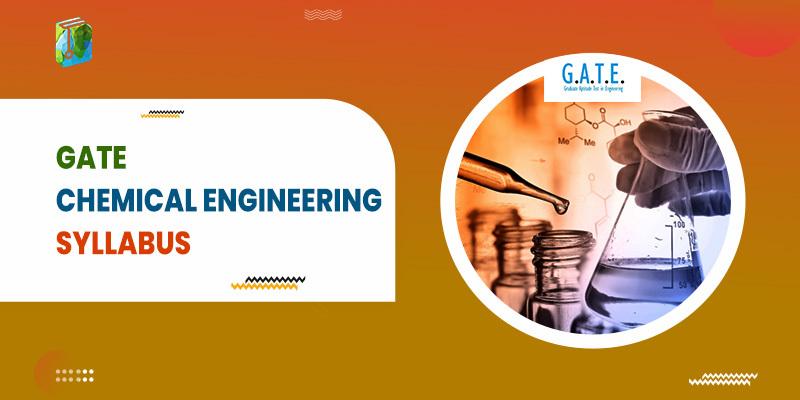The syllabus is a vital part of the examination as it gives information about the topics and subtopics the candidates need to prepare for the examination. The syllabus varies according to the brach opted by the candidate.
This article will give you complete information regarding the GATE Chemical Engineering Syllabus 2024.
GATE Chemical Engineering Syllabus (CH) 2024
GATE Chemical Engineering Syllabus (CH) consists of nine sections such as Engineering Mathematics, Process Calculations and Thermodynamics, Fluid Mechanics and Mechanical Operations, Heat Transfer, Mass Transfer, Chemical Reaction Engineering, Instrumentation, and Process Control, Plant Design and Economics and Chemical Technology.
Engineering Mathematics
Linear Algebra
Algebra of matrices: Inverse and rank of a matrix; System of linear equations; Symmetric, skew-symmetric and orthogonal matrices; Determinants; Eigenvalues and eigenvectors, Diagonalisation of matrices; Cayley-Hamilton Theorem.
Calculus
Functions of a single variable: Limit, continuity, and differentiability; Mean value theorems, Indeterminate forms, and L’Hospital’s rule; Maxima and minima; Taylor’s theorem, Fundamental theorem and mean value-theorems of integral calculus; Evaluation of definite and improper integrals; Applications of definite integrals to evaluate areas and volumes.
Functions of two variables: Limit, continuity, and partial derivatives; Directional derivative, Total derivative; Tangent plane and normal line; Maxima, minima and saddle points, Method of Lagrange multipliers; Double and triple integrals, and their applications.
Sequence and series: Convergence of sequence and series; Tests for convergence, Power series; Taylor’s series; Fourier Series; Half range sine and cosine series.
Vector Calculus
Gradient, divergence, and curl; Line and surface integrals; Green’s theorem, Stokes theorem, and Gauss divergence theorem (without proofs).
Complex Variable
Analytic functions; Cauchy-Riemann equations; Line integral, Cauchy’s integral theorem and integral formula (without proof); Taylor’s series and Laurent series; Residue theorem (without proof) and its applications.
Ordinary Differential Equation
First-order equations (linear and nonlinear); Higher order linear differential equations with constant coefficients; Second-order linear differential equations with variable coefficients; Method of variation of parameters; Cauchy-Euler equation; Power series solutions; Legendre polynomials, Bessel functions of the first kind and their properties.
Partial Differential Equation
Classification of second-order linear partial differential equations; Method of separation of variables; Laplace equation; Solutions of one-dimensional heat and wave equations.
Probability
Axioms of probability; Conditional probability; Bayes’ Theorem; Discrete and continuous random variables: Binomial, Poisson, and normal distributions; Correlation and linear regression.
Numerical Methods
The solution of systems of linear equations using LU decomposition, Gauss elimination and Gauss-Seidel methods; Lagrange and Newton’s interpolations, Solution of polynomial and transcendental equations by Newton-Raphson method; Numerical integration by trapezoidal rule, Simpson’s rule and Gaussian quadrature rule; Numerical solutions of first-order differential equations by Euler’s method and 4th order Runge-Kutta method.
Process Calculations and Thermodynamics
Steady and unsteady state mass and energy balances including multiphase, multicomponent, reacting, and non-reacting systems. Use of tie components; recycle, bypass and purge calculations; Gibb’s phase rule and degree of freedom analysis.
First and Second laws of thermodynamics. Applications of first law to close and open systems. Second law and Entropy. Thermodynamic properties of pure substances: Equation of State and residual properties, properties of mixtures: partial molar properties, fugacity, excess properties, and activity coefficients; phase equilibria: predicting VLE of systems; chemical reaction equilibrium
Fluid Mechanics and Mechanical Operations
Fluid statics, Newtonian and non-Newtonian fluids, shell-balances including the differential form of Bernoulli equation and energy balance, Macroscopic friction factors, dimensional analysis, and similitude, flow through pipeline systems, flow meters, pumps and compressors, elementary boundary layer theory, flow past immersed bodies including packed and fluidized beds, Turbulent flow: fluctuating velocity, universal velocity profile and pressure drop.
Particle size and shape, particle size distribution, size reduction and classification of solid particles; free and hindered settling; centrifuge and cyclones; thickening and classification, filtration, agitation, and mixing; conveying of solids.
Heat Transfer
Steady and unsteady heat conduction, convection and radiation, thermal boundary layer and heat transfer coefficients, boiling, condensation, and evaporation; types of heat exchangers and evaporators and their process calculations. Design of double pipe, shell and tube heat exchangers, and single and multiple effect evaporators.
Mass Transfer
Fick’s laws, molecular diffusion in fluids, mass transfer coefficients, film, penetration, and surface renewal theories; momentum, heat and mass transfer analogies; stage-wise and continuous contacting and stage efficiencies; HTU & NTU concepts; design and operation of equipment for distillation, absorption, leaching, liquid-liquid extraction, drying, humidification, dehumidification, and adsorption.
Chemical Reaction Engineering
Theories of reaction rates; kinetics of homogeneous reactions, interpretation of kinetic data, single and multiple reactions in ideal reactors, non-ideal reactors; residence time distribution, single parameter model; non-isothermal reactors; kinetics of heterogeneous catalytic reactions; diffusion effects in catalysis.
Instrumentation and Process Control
Measurement of process variables; sensors, transducers and their dynamics, process modeling and linearization, transfer functions and dynamic responses of various systems, systems with the inverse response, process reaction curve, controller modes (P, PI, and PID); control valves; analysis of closed-loop systems including stability, frequency response, controller tuning, cascade and feedforward control.
Plant Design and Economics
Principles of process economics and cost estimation including depreciation and total annualized cost, cost indices, rate of return, payback period, discounted cash flow, optimization in process design, and sizing of chemical engineering equipment such as compressors, heat exchangers, multistage contactors.
Chemical Technology
Inorganic chemical industries (sulfuric acid, phosphoric acid, Chlor-alkali industry), fertilizers (Ammonia, Urea, SSP and TSP); natural products industries (Pulp and Paper, Sugar, Oil, and Fats); petroleum refining and petrochemicals; polymerization industries (polyethylene, polypropylene, PVC, and polyester synthetic fibers).
Conclusion
GATE is one of the most competitive examinations that needs complete focus and a good understanding of basic concepts. In order to clear the exam, the candidates must have a thorough preparation.
Candidates must refer to the syllabus and analyze the exam pattern using previous years’ papers and prepare accordingly. Identify topics that have fetched more marks and give more importance to them during your preparation.
Keep taking mock tests regularly. Work hard and do not lose hope.
Good luck with your preparation!
People are also reading:

